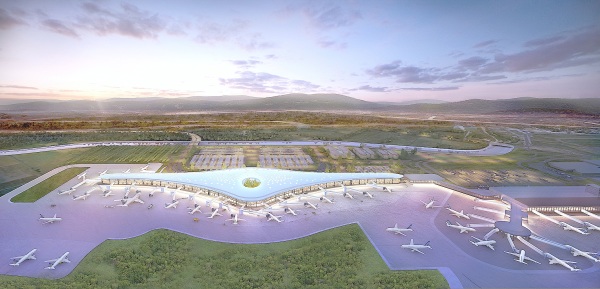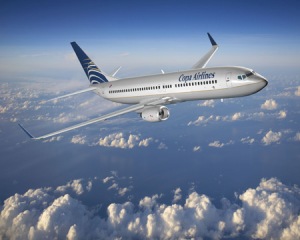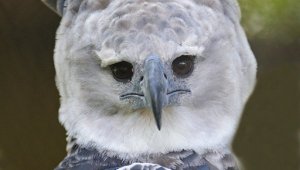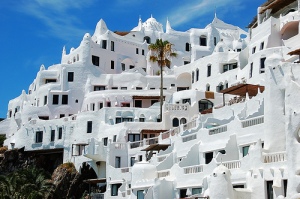As of November 25 this year, Air France will offer a regular flight to Panama City three times a week from Paris-Charles de Gaulle, extending its network to the region Central America, South America and Caribbean.
Flights will be made in Boeing 777-200 equipped with 309 seats: 35 in Business Class, 24 in Premium Economy and 250 in Economy Class.
This new route will complement KLM offer with a daily flight from Amsterdam-Schiphol and will offer customers of Air France and KLM an increased number of connections, thanks to the “hub” of Copa Airlines in Panama City airport of Tocumen, particularly to Costa Rica, Ecuador, Guatemala and Nicaragua.
Next winter, Air France and KLM will operate ten flights per week to Panama and more than 200 flights to 25 destinations in the regions Central America, South America and Caribbean.
Harpy Eagle named “Panama” will arrive in the country on June 15
 On Saturday, June 15 will arrive in Panama at 11:20 am, under tight security, “Panama” Harpy Eagle, coming from the United States to reach the isthmus on loan by the Mayoress of Panama, Roxana Mendez and by Ron Magill, communications director of the Miami Zoo and member of the Friends of the Harpy Eagle Board.
On Saturday, June 15 will arrive in Panama at 11:20 am, under tight security, “Panama” Harpy Eagle, coming from the United States to reach the isthmus on loan by the Mayoress of Panama, Roxana Mendez and by Ron Magill, communications director of the Miami Zoo and member of the Friends of the Harpy Eagle Board.
The species was born in captivity on September 22, 2009 in the Miami Zoo and has three years and eight months.
“Panama” will be the fifth Harpy Eagle which will be hosted by the Summit Municipal Park after “Sony”, “Metro”, “Ancon” and the last “Cheyenne”, who died in 2012 at the approximate age of 45 to 51, after presenting problems in one of its wings and legs from the month of March 2012.
The arrival of “Panama” at Summit Municipal Park will be celebrated with an event that will be held on Monday, June 17 at 10:00 am that will be attended by the Mayoress Mendez, by the U.S. Ambassador in Panama Jonathan Farrar, by Ron Magill and members of Friends of Harpy Eagle Board.
The eagle “Panama”, a female that will stay for 15 days in a cage at the Summit Municipal Park, will be located then in the “Harpy Eagle Observatory”, an area of over 700 square meters with a height of 18 meters. The eagle will be properly fed with rabbit meat and will receive all the care that the national bird of the Republic of Panama deserves.
1,916 tourists last year used the free insurance
 916 thousand tourists last year used the free health coverage offered to all tourists in Panama and Panamanians living abroad entering the country through Tocumen International Airport.
916 thousand tourists last year used the free health coverage offered to all tourists in Panama and Panamanians living abroad entering the country through Tocumen International Airport.
This figure means that 316 additional cases were handled compared to 2011 reports.
Colombia (456 cases), the U.S. (307) Mexico (45) and Peru (39) are, mostly, the nationalities that have used the free insurance that is in effect for the first 30 days the tourist remains in the country .
The Panama Tourism Authority paid over $ 2.9 million to cover the 1.4 million tourists who entered last year by Tocumen.
In the contract, that the Country signed with the insurance company Generali, it is established that the policy covers hospitalization and medical expenses up to $ 7000 for injuries caused by accident or illness, and $ 40,000 for international transfer to a hospital.
Which is the best coffee produced in Panama?
From Monday until today, 8th May, 16 international judges will select the best coffee produced in the Republic of Panama.
In the event, known internationally as Best Of Panama, they will participate beans of the category geisha washed, natural and traditional, as said by Plinio Ruiz, president of the Specialty Coffee Association.
“In this event, where it is judged the coffee produced in the highlands of the Chiriqui province, 24 specialty coffee producers are involved, who want their grains to be chosen as the best in each one of the three categories” said Ruiz.
During the XVII International Coffee Cupping the 46 lots that will pass the first filter will be decided with national judges, who already selected the lots that will be judged by international experts, said the leader of specialty coffee.
Currently there are in storage 28 000 150 pounds of coffee involved in this tasting and after the results of the event they will be sold on the 11th June through an online auction, in which prices will be over $ 100 per pound.
Ruiz ensures that, for the transparency of the cupping, the lots were assigned an alphanumeric code, and the name of the owner will only be disclosed on the day of the closing ceremony in which the winners will be revealed.
International judges will make the coffee tasting in the Bajareque salon of the International Fair of Flowers and Coffee in Boquete, Chiriqui.
Event of year 2012:
In the coffee cupping of last year, coffee Geisha Cantar Don Tito of the farm Los Cantares Estate Coffee, owned by Marie Jackie Mercer Vallarino, won first place in the specialty coffee geisha. While in the traditional coffee category, the winner was the organic coffee Kotowa Duncan, and in the natural coffee category, the winner was the Geisha Kotowa.
Tocumen International Airport expansion
 Tocumen International Airport has decided to bet big. Expected to double its capacity to service 18 million passengers for 2016 with an aggressive investment plan.
Tocumen International Airport has decided to bet big. Expected to double its capacity to service 18 million passengers for 2016 with an aggressive investment plan.
Considered a strategic point for air links between the Americas and the cornerstone of the logistics and multimodal transport, Tocumen International Airport is in constant evolution and modernization to meet its growing demand for passenger and cargo.
Given the increased air operations in Panama, and thanks to the sustained growth of the country as a destination for tourism and business, it is experiencing a new airport terminal renovation and expansion of its structure, becoming one of the most modern airports technologically advanced in Central and South America.
The main air terminal in Panama inaugurated the North Terminal in January, with an investment of $ 100 million, which is a building with two levels of 21,000 square meters. After having opened the North Terminal, the construction of the new South Terminal began in mid-February, in order to overcome the lack of spaces for shipments in the current passenger terminal. This new project includes commercial and hotel infrastructure with an investment of approximately $ 679 million. That’s what it aims to be completed by 2014 by the administration of Tocumen, SA. The new South Terminal comprises about 50,000 square meters of construction and will include new areas of immigration and customs, parking lots, commercial areas and will process up to 15 million passengers a year – explained Juan Carlos Pino, manager of Tocumen, SA.
The expansion project of Tocumen International Airport, which will be built on an estimated area of 150 hectares, was conceived with the objective of maximizing the potential of the main international air gateway of Panama.
This new terminal will be built by the Brazilian company Norberto Odebrecht Construction, which was awarded with the contract to work on the project, that will involve a total investment of $ 679 million.
After completing the expansion, the airport will have 141,000 meters square and 54 boarding gates.
Perform business among friends in Uruguay
 Our presence in CLACSKÅL 2013 (March 11 to 15) at the Conrad Punta del Este Resort & Casino – Uruguay.
Our presence in CLACSKÅL 2013 (March 11 to 15) at the Conrad Punta del Este Resort & Casino – Uruguay.
The SKÅL Movement in Urugay started with the foundation of the Club in Montevideo back in 1955. In 1982, our dear Skåleague Don Rodrigo Marimon and a few others, brought together a number of professionals in Punta del Este and founded the Club with the support of our first President and Skåleague Don Néstor Omar Testa who, during his long career within Skål, held various international positions: President of the South American Committee (C.A.S.) and International Councillor for many years.
Uruguay has hosted Latin American Congresses three times already: 1988 in Punta del Este, 1997 and 2005 in Montevideo, and today, after 25 years, Punta del Este, once again, gladly receives a very large group of more than 380 Skåleagues from 23 different countries. And Experience Panama was there!
I personally feel that SKÅL Congresses are a great opportunity for Skåleagues from different cultures to meet, interact, share and strenghten the ties between each other, over and above the different languages we speak, being able to perform business among friends.
I had the opportunity to visit Casapueblo, the house of noted Uruguayan artist Carlos Páez Vilaró located in Punta Ballena (Whale Point) near Punta del Este. It is a homage to the artist’s son Carlitos Paez, one of the sixteen survivors of the crash of Uruguayan Air Force Flight 571 (the Andean survivors). I found the book that he wrote about this experience as a father full of hope and faith waiting for hugging his son again. The title is “Entre Mi Hijo Y Yo La Luna“, I highly recommend you to read it! Casapueblo is now a citadel-sculpture that includes a museum, an art gallery, and the Hotel Casapueblo. Built around a tin box called La Pionera (The Pioneer), Páez Vilaró designed it with a style that can be equated to the Mediterranean coast houses from Santorini.
 The Sunrise Ceremony is conducted on the terraces of the Museum, at dusk, every day of the year since 1994. It is a very emotional moment in which the spirit of the nature comes out when the orange sun becomes one part together with the ocean. You can’t miss it!
The Sunrise Ceremony is conducted on the terraces of the Museum, at dusk, every day of the year since 1994. It is a very emotional moment in which the spirit of the nature comes out when the orange sun becomes one part together with the ocean. You can’t miss it!
Ana Royo
Experience Panama CEO
The ascent to the summit of Volcan Baru, fascination and perseverance
 Volcan Baru, Chiriqui. – Which Panamanian and foreigner has not dreamed of going to the highest point of the national territory of Panama?
Volcan Baru, Chiriqui. – Which Panamanian and foreigner has not dreamed of going to the highest point of the national territory of Panama?
The interest of both domestic and foreign tourist have increased, due to the curiosity to explore the beauty of a volcano that lies dormant for many years.
During the weekend of 9th and 10th March 2013, a group of the Chamber of Tourism organized the second Baru Boquete Fest, ascending from 7:00 am on Saturday.
Firstly awareness among the group was created, which was composed by over 150 hikers on the need to preserve the Baru volcano – said Travis Taliaferro – president of the group. “It is necessary to develop a tourism development plan for five or ten years, with preservation of all ecosystems” he claimed.
Rubén Batista is a young tour guide that takes tourists to various points of interest in the province of Chiriqui. Batista said that the first time he got to the top of Volcan Baru had mixed feelings, both having overcome a personal challenge as admiring different ecosystems as they go. “I took a few American tourists in December. The rain surprised us, so we decided to camp at the top, there were temperatures fell below 0, but it was a great experience and the tourists could admire both the Atlantic and the Pacific ocean. The tourists were pleased with the trip” he announced.
Batista said that going to Volcan Baru was a personal challenge as a tourism student coming from the province of Chiriqui, because it is a test of the physical and mental condition of each person. One challenge is the slope of Zuto, which is one of the most difficult to steep, the other challenge is to reach the very top where there is a cross, because it is a little dangerous. The young tour guide concluded that it is important to activate plans of conservation and regeneration of flora and fauna on the summit of Volcan Baru.
ABOUT VOLCAN BARU
It is the highest elevation of the country, with a height of 3 000 475 meters above sea level. According to scientific studies, last erupted 400 years ago.
The Volcán Barú (also Volcán de Chiriqui) is the tallest mountain in Panama and is 3,474 metres (11,398 ft) high. It lies about 35 km off the border of Costa Rica.
Due to its height and Panama’s relatively short width, it is possible to see both the Pacific Ocean and Caribbean Sea from Volcán Barú’s peak on a clear day.
Panama is among Latin America’s five fastest-growing economies
 In spite of the European economic crisis and the uncertain future of the United States economy, Panama, Peru, Chile, Colombia, and Bolivia continued to grow at a solid rate in 2012, with Gross Domestic Product (GDP) increasing between 5 and 10 percent in each country. This growth persisted even as Brazil, Mexico, and Argentina encountered difficulties maintaining sustained growth.
In spite of the European economic crisis and the uncertain future of the United States economy, Panama, Peru, Chile, Colombia, and Bolivia continued to grow at a solid rate in 2012, with Gross Domestic Product (GDP) increasing between 5 and 10 percent in each country. This growth persisted even as Brazil, Mexico, and Argentina encountered difficulties maintaining sustained growth.
‘Peru and Chile have accomplished significant gains in their fiscal, monetary, and exchange rate policies while Colombia has demonstrated great advancements in becoming a magnet for foreign investment,’ according to economist Julio Escobar.
Only Panama, Peru, Chile, Colombia, and Bolivia achieved expansion rates in 2012 that exceeded the regional average of 3.5 percent GDP growth.
Colombia achieved growth rates of 5 percent, largely due to increased investment and rapidly growing mining, construction, and agricultural industries. This growth was accompanied by a 25 percent decrease in unemployment and a very tolerable rate of inflation (2.5 percent).
Panama remains one of the fastest growing Latin American countries. The Economic Commission for Latin America (CEPAL) estimates that the country achieved a growth rate of 9.5 percent in 2012, a rate similar to growth rates in India and China. This growth has largely been attributed to an expansion in the banking and commercial sectors, along with million-dollar investments in the expansion of the Panama Canal.
Peru’s economy is increasingly considered the modern ‘Latin American miracle,’ expanding at a rate of 7 percent in 2012. The construction sector, which grew at a rate of 20.5 percent in 2012, along with the commercial and services sectors, have powered this rapid growth. Additionally, favorable fiscal policies and a rapidly-expanding mining sector have increased investment in the country.
Chile’s economy grew at a modest rate of 5.5 percent, largely due to its status as one of the largest exporters in the world. With over 30 trade agreements, Chile has diversified its risk and become the most competitive Latin American country.
Little by little, Bolivia has also risen to become one of the stars of economic growth in Latin America. With GDP growth of 5.1 percent in 2012, the country is transforming its image, largely on the back of an expansion in hydrocarbons, construction, manufacturing, and the export of primary materials.
Panamanian airline Copa growing 14%
 After transporting 10.1 million passengers in 2012, the Panamanian airline Copa Airlines plans to mobilize 11 million people in 2013.
After transporting 10.1 million passengers in 2012, the Panamanian airline Copa Airlines plans to mobilize 11 million people in 2013.
The airline estimates that this year its transport capacity will grow 14% compared to last year when it increased 24%.
Pedro Heilbron, CEO of Copa Airlines, said that during 2013 they will receive 13 new aircraft, to operate a total fleet of 90 aircraft.
The 51.1% of the planes used by Copa come from the U.S. manufacturer Boeing and the rest from the Brazilian company Embraer.
As a long-haul airline, the Panamanian company does not request the Boeing Dreamliner aircraft that is under intense scrutiny from international regulators for the problems it caused, especially due to the lithium batteries used.
For this year the Panamanian airline, which accounts for about 4% of the gross domestic product of the country, will establish four to five new direct flights, including Boston, USA, which will be available from 10th July 2013.
New frequencies will also be added to Brazil, Dominican Republic and the United States.
Heilbron said that the compliance factor of the company – which is the percentage of flights that has not been canceled – closed at 99.8% during 2012.
This year the company plans to hire 700 employees in Panama.
Experience Panama – Embera Tusipono community
An incredible journey into the Chagres National Park to discover the Embera Tusipono community, located along the upper Chagres River.





